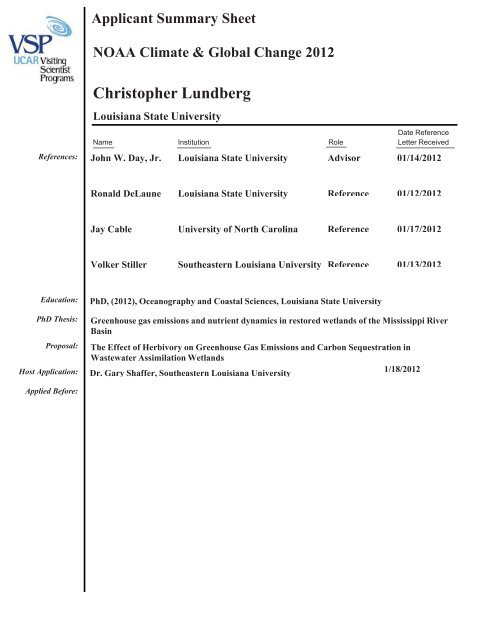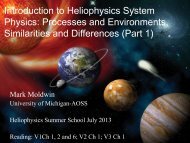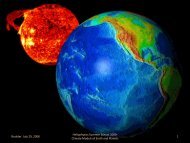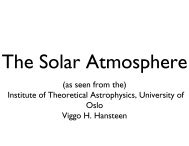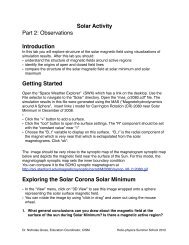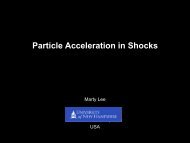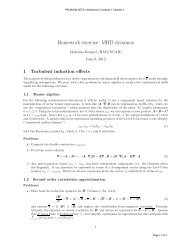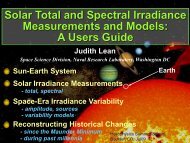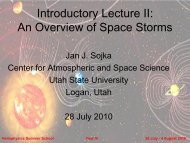Christopher Lundberg - VSP | UCAR Visiting Scientist Programs
Christopher Lundberg - VSP | UCAR Visiting Scientist Programs
Christopher Lundberg - VSP | UCAR Visiting Scientist Programs
- No tags were found...
You also want an ePaper? Increase the reach of your titles
YUMPU automatically turns print PDFs into web optimized ePapers that Google loves.
Applicant Summary SheetNOAA Climate & Global Change 2012References:<strong>Christopher</strong> <strong>Lundberg</strong>Louisiana State UniversityNameInstitutionDate ReferenceLetter ReceivedJohn W. Day, Jr. Louisiana State University Advisor 01/14/2012RoleRonald DeLaune Louisiana State University Reference 01/12/2012Jay Cable University of North Carolina Reference 01/17/2012Volker Stiller Southeastern Louisiana University Reference 01/13/2012Education:PhD Thesis:Proposal:Host Application:PhD, (2012), Oceanography and Coastal Sciences, Louisiana State UniversityGreenhouse gas emissions and nutrient dynamics in restored wetlands of the Mississippi RiverBasinThe Effect of Herbivory on Greenhouse Gas Emissions and Carbon Sequestration inWastewater Assimilation WetlandsDr. Gary Shaffer, Southeastern Louisiana University1/18/2012Applied Before:
January 12, 2012<strong>UCAR</strong> <strong>Visiting</strong> <strong>Scientist</strong> <strong>Programs</strong>P.O. Box 3000Boulder, CO 80307-3000 USADear Administrator:With the included application, I wish to be considered for participation in the NOAA Climateand Global Change Postdoctoral Fellowship Program 2012. The included project descriptionoutlines the proposed research; namely, an investigation of carbon sequestration and greenhousegas emissions in wastewater assimilation marshes in southeast Louisiana. As a doctoral student,I researched nitrous oxide and methane emissions in coastal and freshwater wetlands underrestoration. As a master’s students, I investigated the effects of treated wastewater onbaldcypress growth and plant community dynamics. This postdoctoral fellowship will allow meto further my research interests and provide the scientific community further insight into thepotential of using assimilation wetlands to decrease climate change impacts.I am grateful for your consideration, and would be more than happy to provide furtherinformation. Feel free to contact me by email at clundb1@lsu.edu or by telephone at985.974.2861.Sincerely,Chris <strong>Lundberg</strong>
<strong>Christopher</strong> J. <strong>Lundberg</strong>26781 Blahut Rd., Hammond, LA 70403(985) 974-2861, clundb1@tigers.lsu.eduEDUCATIONDoctorate of Philosophy, Oceanography & Coastal Sciences, May 2012Louisiana State University, Baton Rouge, LADissertation: Greenhouse gas emissions and nutrient dynamics in restored wetlands ofthe Mississippi River BasinAdvisor: Dr. John W. Day, Jr.Minor: Experimental StatisticsMaster of Science, Biological Sciences, May 2008Southeastern Louisiana University, Hammond, LAThesis: Using secondarily-treated sewage effluent to restore baldcypress-water tupeloswamps of the Lake Pontchartrain Basin: a demonstration studyAdvisor: Dr. Gary P. ShafferBachelor of Science, Biological Sciences, December 2005Southeastern Louisiana University, Hammond, LAConcentration: Ecology/Environmental/Evolutionary BiologyRESEARCH EXPERIENCEResearch Associate 4, Oceanography & Coastal Sciences, Louisiana State University,Baton Rouge, LAJuly 2011 – December 2011 Conducted light/dark bottle experiments to determine estuarine phytoplanktonprimary productivity response to oil pollution under various light regimes Organized personnel and maintained equipment used in conducting coastal research Analyzed ecological data using multivariate techniquesGraduate Research Assistant, Oceanography & Coastal Sciences, Louisiana StateUniversity, Baton Rouge, LAAugust 2009 - June 2010 Collected and analyzed greenhouse gas samples to determine emissions from wetlandsoilsCollected water samples for nutrient analysisUtilized sediment elevation tables (SETs) and feldspar marker horizons to determinewetland accretionGraduate Research Assistant, Biological Sciences, Southeastern Louisiana University,Hammond, LAAugust 2006 - May 2008 Conducted biological surveys to describe wetland plant community dynamics inresponse to the application of treated wastewater effluent Planted and measured baldcypress seedlings to monitor growth
Measured marsh standing herbaceous biomass by collecting clip plotsAssisted in wetland mesocosm studies investigating plant community and standingcrop productivity responses to varying hydrologic and salinity regimesStatistically analyzed multivariate and univariate ecological dataTEACHING EXPERIENCETeaching Assistant, Oceanography & Coastal Sciences, Louisiana State University, BatonRouge, LAAugust 2008 - July 2009; August 2010 - May 2011 Advised undergraduate students during office hours Graded quizzes and assignments Maintained attendance records Lectured on coastal features and wetland ecologyAWARDS Coastal Restoration and Enhancement through Science and Technology (CREST)Award, 2006-2007. Graduate Assistantship, Southeastern Louisiana University, 2006-2008. Graduate Assistantship, Louisiana State University, 2008-2011.AFFILIATIONS Society of Wetland <strong>Scientist</strong>s (SWS). Coastal and Estuarine Research Foundation (CERF).PUBLICATIONS<strong>Lundberg</strong>, C.J., DeLaune, R., Day, J.W. and Lane, R.R. Greenhouse gas emissions inrestored wetlands at floodplain and deltaic sites in the Mississippi River Basin (in review).<strong>Lundberg</strong>, C.J., Day, J.W., and Lane, R.R. Spatial and temporal variations in nutrientsand water quality parameters in the diversion-impacted Breton Sound estuary (in review).<strong>Lundberg</strong>, C.J., Shaffer, G.P., and Wood, W.B. Plant community response to the onset ofwastewater discharge in an assimilation marsh (in review).<strong>Lundberg</strong>, C.J., Shaffer, G.P., Wood, W.B. and Day, J.W. 2011. Growth rates ofbaldcypress (Taxodium distichum) seedlings in a treated effluent assimilation marsh.Ecological Engineering 37:549-553.PRESENTATIONS<strong>Lundberg</strong>, C.J. and G. P. Shaffer. 2008. Baldcypress restoration in a wastewaterassimilation wetland in the Lake Pontchartrain basin. Society of Wetland <strong>Scientist</strong>s,Washington, D.C.<strong>Lundberg</strong>, C.J., Day, J.W. and Lane, R.R. 2011. The effects of oil pollution on aquaticprimary productivity of a Louisiana coastal estuary. 21 st Biennial Conference of theCoastal and Estuarine Research Foundation, Daytona Beach, FL.
Reference List:<strong>Christopher</strong> J. <strong>Lundberg</strong>John W. Day, Jr.Professor EmeritusDept. of Oceanography and Coastal SciencesLouisiana State University2237 Energy Coast and Environment Building (225) 578-6508Baton Rouge, LA 70803johnday@lsu.eduRonald D. DeLauneProfessor – ResearchDept. of Oceanography and Coastal SciencesLouisiana State University3171 Energy Coast and Environment Building (225) 578-6421Baton Rouge, LA 70803rdelaun@lsu.eduJaye E. CableProfessorDept. of Marine SciencesUniversity of North Carolina – Chapel HillCB-3300, 4202H Venable Hall (919) 843-3468Chapel Hill, NC 27599jecable@email.unc.eduVolker StillerAssociate ProfessorDept. of Biological SciencesSoutheastern Louisiana University303 Biology Building (985) 549-2493Hammond, LA 70402vstiller@selu.edu
Dissertation AbstractGreenhouse Gas Emissions and Nutrients Dynamics in Restored Wetlands of the MississippiRiver BasinGreenhouse gases were sampled during spring and summer months in 2010 and 2011 at two sitesin the Mississippi River Basin: a riparian forested wetland under restored flood pulsing nearMemphis, TN and a coastal estuarine marsh complex impacted by a river diversion atCaernarvon, LA. Mean methane fluxes at Caernarvon (-0.09 g CH 4 -C m -2 d -1 ) were lower thanthose at Memphis (0.53 g CH 4 -C m -2 d -1 ), and did not differ between seasons. Nitrous oxidefluxes were generally below detection limits. Fluxes were uncorrelated with water depth, soiltemperature, and ambient air temperature, though sampling occurred over a narrow range ofthese variables due to limitations in site accessibility.A water quality dataset spanning 8 years of monthly sampling was analyzed to determine longtermspatial and temporal patterns in nutrient concentrations at Caernarvon. The estuary servedas a source of ammonium, and chlorophyll a and a sink for nitrate, total nitrogen and totalsuspended sediments. Classification of the estuary as a source or sink for phosphate, totalphosphorus and silicate changed with the seasons. Nitrate removal efficiency varied seasonally,with efficiency highest in the fall (98%), summer (92%) and spring (87%) and lowest in thewinter (74%). Removal efficiency was inversely related to loading rate.Water quality samples were collected at Memphis in a secondary channel of the MississippiRiver under restored hydrology during spring and summer 2010-2011. Seasonal variationsexisted in concentrations of nitrate, total nitrogen, total phosphorus and total suspended solids,but not ammonium, phosphate, silicate, dissolved oxygen and chlorophyll a. No parametersvaried longitudinally or laterally within the channel. Nitrate loading rate was high and removalefficiency was low, especially in comparison with Caernarvon and other study sites within theMississippi River Basin, due to the limited size of the receiving wetland.
Project DescriptionThe Effect of Herbivory on Greenhouse Gas Emissions and Carbon Sequestration in WastewaterAssimilation WetlandsWetlands of coastal Louisiana (USA) perform important ecological functions which result ineconomic benefits including improved water quality, nutrient cycling, endangered specieshabitat, fisheries nurseries, recreational hunting and ecotourism (Reed and Wilson, 2004).However, the state of Louisiana has experienced wetland loss on a grand scale (Barras et al.1994, Day et al. 2000, 2007). The majority of the Lake Maurepas wetland complex, located insoutheast Louisiana, is described as degraded or degrading (Shaffer et al., 2009). Maurepaswetlands require restoration efforts that provide a large source of fresh water to prevent longtermsalinity pulses , (<strong>Lundberg</strong>, 2008; Thomson, Shaffer and McCorquodale, 2001). Onepotential source of fresh water for restoration efforts is secondarily-treated wastewater effluent.Wastewater assimilation wetlands (WAWs) have been shown to be an energy- and cost-effectivemeans of improving effluent water quality, increasing accretion, and promoting primaryproductivity (Day et al., 2004; Ko et al., 2004). Assimilation wetlands are currently operationalfor a number of municipalities in south Louisiana (Day et al., 2004). However, greenhouse gasflux and carbon sequestration studies in the region have been sparse. Additionally, the effects ofintensive herbivory by the non-native nutria (Myocaster coypus) on these processes have notbeen explored in WAWs. If selected as a fellow, I would utilize a WAW that has beenoperational for five years to conduct such research.In the fall of 2006, the city of Hammond began discharging municipal disinfected secondarysewage effluent into Four Mile Marsh (Figure 1). A 10-km buried pipeline was installed runningfrom the wastewater facility, where primary and secondary treatment and disinfection of thewater occurs, to the southern assimilation marsh. The pipeline is elevated 2 m at the marsh siteand is situated along a spoil levee separating the treatment marsh from the South Slough canaljust to the north (Figure 2). The wastewater is discharged into the marsh via 900 7.62-cmdiameter polyvinyl chloride (PVC) pipes emanating from the elevated pipe, though only 150PVC pipes are operational at a given time. Discharge pipes can thus be turned on or off, ormoved east or west, depending on environmental management practices or mechanical factors.Since operation began, the marsh has been extensively planted with baldcypress (Taxodiumdistichum) and water tupelo (Nyssa aquatic) seedlings in an effort to regenerate the historicaldominant forested wetland community of the region.This has served as a site for several ecological studies, and a great deal has been learned aboutthe system. For example, the marsh promotes baldcypress growth better than non-assimilationmarshes nearby (Figure 3) (<strong>Lundberg</strong> et al., 2011) and growth varies in response to nutrientavailability, evidenced by decreased growth with increasing distance from the outfall (Figure 4).
The introduction of effluent to the marsh has lead to structural changes in the marsh plantcommunity (<strong>Lundberg</strong>, 2008). The marsh has been shown to effectively remove nutrients,including nitrate (Hunter et al., 2009). Shortly after discharge, an increase in standing cropbiomass was observed (Figure 5) (<strong>Lundberg</strong>, 2008). This was followed by an influx of nutria(Myocastor coypus), an invasive herbivore. Nutria are capable of denuding local herbaceousplant communities through massive “eat-outs”, often resulting in a loss of productivity anddiversity (Shaffer et al., 1992), which also occurred at Four Mile Marsh (<strong>Lundberg</strong>, 2008). Sincenutria management practices were adopted, the marsh has partially recovered, and studies showthat excluding nutria in the area result in increased productivity and diversity.Figure 1: Four Mile Marsh wastewater assimilation wetland ; one transect of sampling siteswould be established within each subunit depicted.
Figure 2: The elevated wastewater pipe at Four Mile Marsh.Figure 3: Mean (+ 1 s.e.) basal diameter growth of baldcypress seedlings planted within fourexperimental subunits (1-4) and a control (C). Bars with different letters indicate a Bonferroniadjustedstatistical difference. Subunits 1-4 located within the assimilation marsh.Figure 4: Mean (+ 1 s.e.) basal diameter growth of baldcypress seedlings at various distancesfrom effluent discharge within the experimental subunits. Bars with different letters indicate aBonferroni-adjusted statistical difference. Subunits 1-4 located within the assimilation marsh.
Figure 5: Mean (+ 1 s.e.) aboveground herbaceous standing crop of permanent study plotswithin treatment subunits (subunits 1-4) and a control marsh (C) following Phase I discharge.Bars with different letters indicate a Bonferroni-adjusted statistical differenceFour Mile Marsh provides an ideal setting for investigating carbon sequestration and greenhousegas dynamics. A nutrient gradient exists, with concentrations of nitrate, ammonium andphosphate decreasing with increasing distance from the effluent outfall (Hunter et al., 2009;<strong>Lundberg</strong>, 2008). The marsh has been divided into different subunits to investigate how variouswater management techniques, especially pulsing specific areas of the marsh, would affectseedling growth. For this project, a transect would be established within each subunit, includingthe hydrologically-isolated control subunit, for a total of five 700 m transects. A minimum offive study plots will be established along each transect to capture differences due to distancefrom effluent outfall. Each distance plot will have a 16 m 2 caged and uncaged plot. This willallow us to characterize the effect of herbivory on greenhouse gas fluxes and carbonsequestration.Plexiglas diffusion chambers measuring 0.284 m 3 with a surface area of .093 m 2 will befabricated after Faulkner et al. (1989). The top of each diffusion chamber will be constructedwith an open bottom and sampling port at the top closed with a rubber septum, through whichgases are collected using a syringe. To minimize the potential for out-fluxing of gases from thesoil due to walking and placing the bases on the marsh surface, permanent bases for chamberswill be installed prior to sample collection, and permanent boardwalks placed on the marshsurface will be used during sample collection. Chambers will be placed atop each permanentlyinstalled base. Air temperature, soil temperature and water depth will be recorded during eachsampling period. Three replicate chambers will be used at each transect-distance-herbivorytreatment plot. Samples will be analyzed for nitrous oxide, methane, and carbon dioxide. A
preliminary study will be conducted to determine the length of time required to determine fluxesof each gas. Additionally, carbon sequestration will be investigated by quantifying rates ofaboveground and belowground productivity, organic matter burial and decomposition at eachstudy site. Statistical analyses would be conducted using a completely randomized 2x5x5treatment arrangement design with replication and non-metric multidimensional scaling. Bycharacterizing greenhouse gas emissions and carbon sequestration, determinations about thepotential of WAWs in carbon banking could be used in public policy decision-making.Literature CitedDay, J. W., Ko, J.-Y., Rybczyk, J., Sabins, D., Bean, R., Berthelot, G., Brantley, C., Cardoch, L.,Conner, W., Day, J. N., Englande, A. J., Feagley, S., Hyfield, E., Lane, R., Lindsey, J.,Mistich, J., Reyes, E. & Twilley, R. 2004. The use of wetlands in the Mississippi Deltafor wastewater assimilation: a review. Ocean & Coastal Management, 47, 671-691.Faulkner, S. P., Patrick, W. H., Jr. & Gambrell, R. P. 1989. Field techniques for measuringwetland soil parameters. Soil Sci Soc Am J, 53, 883-890.Hunter, R., Lane, R., Day, J., Lindsey, J., Day, J. & Hunter, M. 2009. Nutrient removal andloading rate analysis of Louisiana forested wetlands assimilating treated municipaleffluent. Environmental Management, 44, 865-873.Ko, J.-Y., Day, J. W., Lane, R. R. & Day, J. N. 2004. A comparative evaluation of money-basedand energy-based cost–benefit analyses of tertiary municipal wastewater treatment usingforested wetlands vs. sand filtration in Louisiana. Ecological Economics, 49, 331-347.<strong>Lundberg</strong>, C. J. 2008. Using secondarily treated sewage effluent to restore the baldcypress-watertupelo swamps of the Lake Pontchartrain Basin: A demonstration study. M.S.,Southeastern Louisiana University,71 p.<strong>Lundberg</strong>, C. J., Shaffer, G. P., Wood, W. B. & Day Jr, J. W. 2011. Growth rates of baldcypress(Taxodium distichum) seedlings in a treated effluent assimilation marsh. EcologicalEngineering, 37, 549-553.Reed, D. & Wilson, L. 2004. Coast 2050: A new approach to restoration of Louisiana coastalwetlands. Physical Geography, 25, 4-21.Shaffer, G. P., Sasser, C. E., Gosselink, J. G. & Rejmanek, M. 1992. Vegetation dynamics in theemerging Atchafalaya Delta, Louisiana, USA. Journal of Ecology, 80, 677-687.Shaffer, G. P., Wood, W. B., Hoeppner, S. S., Perkins, T. E., Zoller, J. & Kandalepas, D. 2009.Degradation of baldcypress-water tupelo swamp to marsh and open water in southeasternLouisiana, U.S.A.: An irreversible trajectory? Journal of Coastal Research, 152-165.Thomson, D. M., Shaffer, G. P. & Mccorquodale, J. A. 2001. A potential interaction betweensea-level rise and global warming: implications for coastal stability on the MississippiRiver Deltaic Plain. Global and Planetary Change, 32, 49-59.
Statement of RelevanceAs a NOAA fellow, I propose a research project that would investigate greenhouse gas emissionsand carbon sequestration in a wastewater assimilation wetland in southeast Louisiana. Inreviewing the climate objectives of NOAA’s Climate Program Office, I notice that emphasis isplaced on advances leading to “…more comprehensive knowledge of greenhouse gases and otherclimate-forcing agents.” The proposed research will give insight regarding greenhouse gasfluxes in assimilation wetlands, as well as the edaphic factors, including soil organic matter,redox potential and pH, that influence fluxes in these systems. Coupled with the insight gleanedfrom the carbon sequestration research that will be conducted, the potential of the use ofassimilation wetlands in carbon banking will be determined. These determinations could be usedto inform policy-makers and landowners regarding land-use decisions. This would assistNOAA’s Climate Program Office in meeting its “…highest priority over the next two years…”by “…developing and delivering the climate mitigation and adaptation information, products,and services that stakeholders need, at appropriate time and space scales, for use in climaterelateddecision in their lives, businesses, and communities.” For these reasons, I feel thisresearch would help further the goals and objectives of NOAA’s Climate Program.
LOUISIANA STATE UNIVERSITYAND AGRICULTURAL AND MECHANICAL COLLEGEDepartment of Oceanography and Coastal Sciences JOHN W. DAY, JR.School of the Coast and EnvironmentBaton Rouge., LA 70803 phone 225-578-6508 fax 225-578-6326email johnday@lsu.eduJan. 14, 2012To Whom It May ConcernRe: Letter of support for Dr. Chris <strong>Lundberg</strong>This is a letter of support for Dr. Chris <strong>Lundberg</strong> who is applying for a NOAA post-doctoralfellowship in their Climate and Global Change program. Dr. <strong>Lundberg</strong> recently completedhis PhD in the Department of Oceanography and Coastal Sciences at LSU. I served as hismajor professor. Before coming to LSU for his doctoral studies, he received a MS atSoutheastern Louisiana University.For his dissertation, Chris worked on a large project investigating the impact of riverine inputon nutrient dynamics and greenhouse gas emissions in three wetland areas of the MississippiBasin. These included small riparian wetlands in the upper basin in Ohio, the alluvialfloodplain near Memphis, and deltaic wetlands in the Mississippi delta. Chris’ dissertationtopic addressed greenhouse gas emissions in the alluvial plain and delta wetlands. He wasinvolved in setting up the field experiments and collecting data, statistical analysis of thedata, and preparation of manuscripts. Although I was responsible for overall oversight on theproject, Chris worked independently much of the time and was largely responsible forcarrying out the fieldwork for his part of the project and ensuring its success. But this was ateam effort and Chris interacted very well with all project participants. In his coursework atLSU, he received grades of A for almost all courses. In both his research and coursework, hedemonstrated a high level of intelligence, independent, diligence, and hard work. Chris hasexcelled in his work at LSU as well as at Southeastern. He has published one paper from hisMS project and a second is currently being revised. Within a week or two he will havesubmitted two additional manuscripts based on his dissertation work. In addition, he isworking a third manuscript that integrates nutrient uptake and loading relationships at thethree study areas of the Mississippi basin project. In all of his work, Chris has demonstrateda high level of intelligence and creativity I have served as major professor for 68 studentsand Chris is easily in the top 10.His work at Southeastern and LSU have prepared him well for the proposed post doctoralwork on greenhouse gas emissions in wetlands. He has developed skills in wetland ecology,nutrient biogeochemistry, and greenhouse gas dynamics. More generally, he hasdemonstrated that he can carry out scientific studies from writing successful proposals, tocarrying out the work and analyzing data, to publishing. He has shown that he is a productive
team member on large multidisciplinary projects. Chris is very intelligent, extremely hardworking and dedicated. In summary, I believe that he is ideally suited for the NOAA postdoctoral fellowship and I give him my highest recommendation. If you have any questionsabout him, please do not hesitate to contact me.Sincerely,John W. Day Jr.Distinguished Professor Emeritus
THE UNIVERSITY of NORTH CAROLINAat CHAPEL HILLJanuary 17, 2012<strong>UCAR</strong> / <strong>Visiting</strong> <strong>Scientist</strong> <strong>Programs</strong>P.O. Box 3000Boulder, CO 80307-3000, USAJaye Cable, ChairCurriculum for Environment and Ecology4202H Venable Murray HallCampus Box 3300Chapel Hill, NC 27599-3300T: (919) 843-3468F: (919) 962-1254jecable@email.unc.eduDear Selection Committee:I am delighted to write this letter of recommendation Dr. <strong>Christopher</strong> <strong>Lundberg</strong> for the NOAA/<strong>UCAR</strong>Postdoctoral Fellowship. I have known Chris in my capacity as one of his PhD committee members forthe last three and a half years and as the instructor for Chemical Oceanography at Louisiana StateUniversity. I moved to UNC last January, but Chris was always very good about keeping in touch withhis committee about his progress. Chris has been a hardworking and diligent young scientist throughoutmy acquaintance with his work. I would rank him in the top 12% of students graduating from theDepartment of Oceanography and Coastal Sciences at LSU.I will offer my assessment of Chris’s potential as a scientist and his scholarship potential. Chris haspublished two papers from his Master’s research which is a very strong sign of his ability to followthrough on his work. He also has strong statistical skills, honed while doing his BS and MS degreesunder the direction of Dr. Gary Schaeffer, which proved of great use to him during his dissertation dataanalysis. He is still writing his papers from his dissertation research, but my sense from his defense inDecember is that these papers would be submitted this spring. The committee asked for a number ofrevisions to his work, all of which were designed to strengthen the papers. Chris is a mild-mannered andquiet person who steadily works toward his goals. He remained in contact with me throughout the winterholiday break asking questions and getting clarification about comments. I was impressed with hisattention to detail.Overall, I believe Chris has developed into a competitive young scientist. He has the tools to become anexcellent educator-scientist if provided with the right outlet. The <strong>UCAR</strong> post-doctoral scholar/visitingscientist program is an excellent avenue for Chris to pursue where he can merge his skills inbiogeochemical cycling, statistics, and climate change with the practical applications of carbonsequestration. I highly recommend <strong>Christopher</strong> <strong>Lundberg</strong> for this program.Sincerely,Jaye CableProfessor of Marine ScienceChair, Curriculum for the Environment and Ecology
Volker Stiller, Ph. D.Department of Biological SciencesSoutheastern Louisiana UniversitySLU Box 10736Hammond, LA 70402January 13, 2012Dear Members of the Steering Committee,I am happy to write this letter in support of <strong>Christopher</strong> <strong>Lundberg</strong>’s application for a NOAA Climateand Global Change Postdoctoral Fellowship.I met Chris a few years ago when he took graduate level Plant Physiology and Advanced StressEcophysiology with me. In both courses, Chris impressed me with his intellectual aptitude and hard workethic. He was clearly at the top of both classes. For example, a large component of the Stress EcoPhyscourse was an independent research project that the students had to write a proposal for, design theexperiment, and present the results in form of a PowerPoint presentation and as a written final report. Notonly did Chris come up with a very unique and creative idea, but he also worked harder on his project thansome other, more “senior”, graduate students.After getting to know Chris in the classroom, I was happy to oblige when he asked me to serve on hisMasters Thesis Committee. I trained him in the use of several instruments and I was very much impressedhow quickly Chris was able to master the required techniques. Chris is a hard worker; he is technicallyadept and always ready to lend a helping hand.Although it was a pleasure having Chris as a student and a research assistant, reducing him solely to hisintellectual aptitude would not do him justice. Chris has a great personality and he is very reliable in everyaspect. He is an exceptionally dedicated researcher with an outstanding sense of humor, whose “can do”attitude will be invaluable in his future career.Let me conclude this letter by once again wholeheartedly supporting <strong>Christopher</strong> <strong>Lundberg</strong>’sapplication for a Postdoctoral Fellowship. Chris has great scientific potential, a wonderful personality andhe is very consistent in his effort to become an environmental scientist.If you have any other question about Chris or need additional information, feel free to call me at (985)549-2493 or contact me via email at: vstiller@selu.edu.Sincerely,Volker Stiller, Ph.D.


